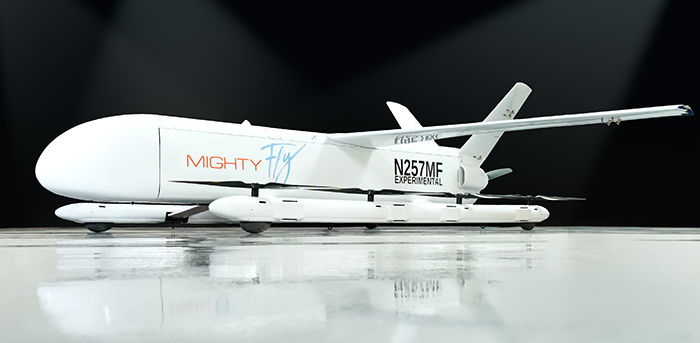Just 21 months after receiving $5.1 million seed funding and with only nine months from concept to first flight, MightyFly is unveiling the next generation of its aircraft, the MightyFly Cento.
The Cento is a hybrid, electric Vertical Takeoff and Landing (VTOL) aircraft with a cargo capacity of 100 lbs (45 kg), a range of 600 miles (965 km) and a max speed of 150 mph (240 km/hr).
With eight electric vertical lift fans, one forward propulsion propeller, and a high wing carbon fiber airframe, the fully loaded Cento weighs just 355 pounds (161 kg). It measures 13.1 ft by 16.7 ft (4 m by 5 m) taking up a total area that is less than two compact cars.
The Cento is equipped with a 6 ft by 1 ft by 1 ft (1.8 m by 0.30 m by 0.30 m) internal cargo bay able to carry 96 small USPS packages. Cargo is loaded and unloaded by a conveyor belt that operates autonomously.
Because the Cento is equipped with a hybrid powertrain, it does not require recharging between flights. An internal combustion engine recharges the aircraft’s battery while in the air, enabling it to perform multiple consecutive deliveries.
“The traditional hub-and-spoke distribution model doesn’t serve everyone,” said Manal Habib, MightyFly CEO and co-founder. “We need to be able to adapt to various cargo volumes and expedited timing. Medical companies, just-in-time manufacturing, and retailers that now provide same-day delivery need a faster and more affordable way to get their goods and perishables to the final destination.”
The Federal Aviation Administration (FAA) has granted the MightyFly Cento a Special Airworthiness Certificate and a Certificate of Authorization (COA) for long-range flights. This allows the company to operate in a larger airspace (230 square miles) to test the transition from hover to forward flight at medium and high altitudes (up to 5,000 feet).
MightyFly has also been granted an SBIR award by the U.S. Air Force. With no required ground-charging infrastructure and long-range capability, both afforded by its hybrid propulsion, the Department of Defense is in support of its development for military applications.



